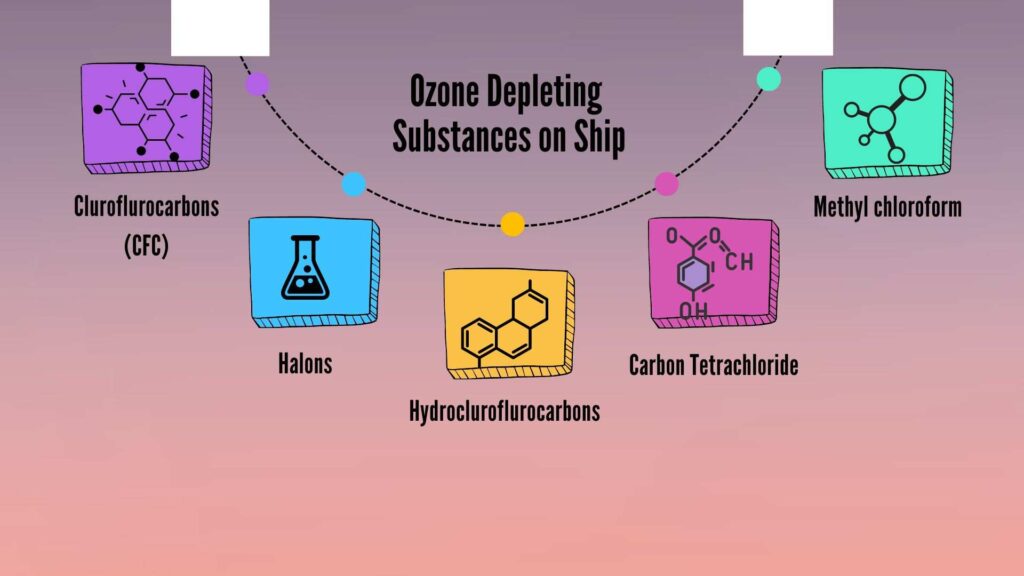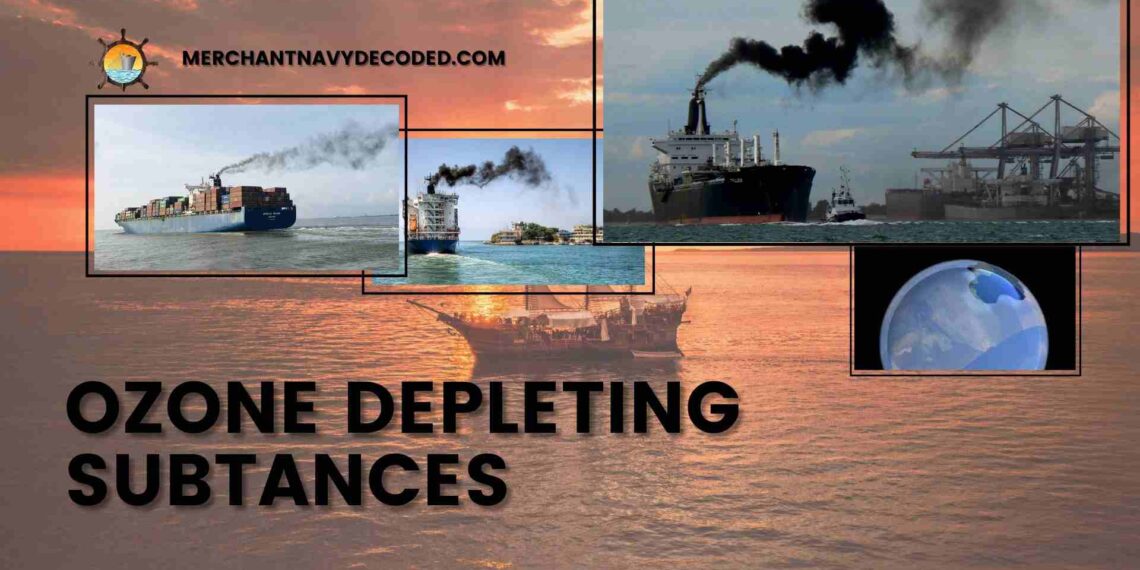What are Ozone Depleting Substances on Ship
1:- Overview
The shield of ozone located at the highest atmospheric level is crucial for life. This shields us from skin cancer, cataracts, and harm to our environment by blocking most of the harmful ultraviolet (UV) rays from the sun. Nonetheless, Ozone-depleting substances (ODS) which are human-made chemicals have been a major challenge to this important layer. The maritime industry has extensively used ODS, raising major concerns, which is why controls are in place and a global phase-down is ongoing.
2:- What are Ozone-Depleting Substances (ODS) on Ship
Ozone-depleting substances are man-made chemicals that, once released into the atmosphere, break down the ozone layer. They contain chlorine and/or bromine atoms, which react with ozone molecules and cause their destruction.
3:- Types of Ozone Depleting Substances on Ship

1. Chlorofluorocarbons (CFCs): Widely used in refrigeration, air conditioning, foam blowing, and aerosol propellants.
2. Halons: Primarily used in fire suppression systems due to their effectiveness in extinguishing flames.
3. Hydrochlorofluorocarbons (HCFCs): Introduced as transitional replacements for CFCs, but they also have ozone-depleting potential.
4. Carbon tetrachloride (CCl4): Used as a solvent and in fire extinguishers.
5. Methyl chloroform (CH3CCl3): A solvent used in various industrial applications.
6. Methyl bromide (CH3Br): A fumigant used in agriculture and shipping.
4:- Ozone Depleting Substances on Ships:
While the overall use of ozone-depleting substances on ships has significantly declined due to regulations and phase-out efforts, understanding their historical applications is crucial to grasp the scope of the issue and the ongoing transition to more sustainable alternatives.
4.1. Refrigeration and Air Conditioning Systems:
- Refrigerants: R-11, R-12, and R-22 / HCFCs / and R-11 CFCs were widely used in the refrigeration system of food preservation, cooling of cargo, and air conditioning in ships. Their stability, non-flammability, and effectiveness in the cooling process made these substances highly prized.
- Challenges: Refrigerant gas leakage, from old systems was a clear and direct threat to the ozone layer. Technicians needed to handle the maintenance and repair of these systems precisely to ensure they salvaged the refrigerants and prevented them from escaping into the atmosphere.
4.2. Fire Suppression Systems:
- Halons: Halon 1301 and Halon 1211 were commonly used in fire protection applications, especially in an engine room or other special risk zones. They were successful in putting out fires because of the interruption of the chemical bonds that are characteristic of fires.
- Challenges: The let-off of halons during fire episodes or testing in this case was relevant in the depletion of the ozone layer. The process of selecting reasonable substitutes as effective as halons posed many difficulties, leading to the use of other agents such as inert gases and water mist systems.
4.3. Insulation:
- Blowing agents: Manufacturers used CFCs and HCFCs to produce foam insulation materials, such as polystyrene panels. These materials made up the cellular structure of the foam and imparted excellent thermal insulation properties.
- Challenges: The Insulation section of the foam and many blowing agents conventionally used in it contribute to ODS emissions through its gradual release over time. Replacing these substances with safer, more environmentally friendly alternatives like hydrofluoroolefins (HFOs) and hydrocarbons required careful consideration of the insulation properties needed to ensure safety, making the task challenging.
4.4. Additional Applications:
- Solvent Cleaning: People use ozone-depleting substances as solvents for cleaning delicate equipment and components.
- Sterilization: Certain ODS were used in sterilization processes, although this was less common on ships compared to other industries.
5:- Challenges and Solutions:
The management of ODS on ships presented several challenges, including:
- Detecting Leaks and Doing Repairs: Essential for preventing emissions, is finding the leaks in refrigeration/air conditioning (RAC) or fire suppression systems, done as per requirement of detection intervals.
- Recovery and Recycling of Refrigerant: Correct recovery and recycling of refrigerants whenever any maintenance or system replacement takes place were essential to prevent the release into the atmosphere.
- Alternative Technologies: The identification of suitable alternatives to replace ODS in numerous applications necessitated a significant amount of research and development efforts.
- MARPOL and Montreal Protocol Compliance: Ship owners/operators faced operational/logistical challenges delivering to MARPOL regulations/The Montreal Protocol.
6:- Control of Ozone Layer Depletion Due to ODS
6.1:- MARPOL Annex VI

The United Nations (UN) agency responsible for developing and overseeing regulations to prevent pollution from ships is the International Maritime Organization (IMO). The MARPOL Convention is the main international convention covering the prevention of pollution of the marine environment by ships.
- MARPOL Annex VI, adopted in 1997 and entered into force in 2005, deals with the prevention of air pollution from ships. It limits the main air pollutants contained in ships’ exhaust gas, including sulfur oxides (SOx) and nitrous oxide (NOx), and prohibits deliberate emissions of ozone-depleting substances.
6.2:- MARPOL ODS Regulation 12:
This regulation is dedicated to the control of ODS on ships. It prohibits the deliberate emission of ODS into the atmosphere and imposes restrictions on their use and installation. The key provisions of Regulation 12 include:
- Prohibition on new installations: It is also forbidden to install equipment that contains CFCs or halons in vessels built after May 19, 2005.
- Elimination of HCFCs: For ships built on or after 1 January 2020, the installation of new equipment using HCFCs was not allowed.
- Recharge of existing recharging may be performed on any system containing an ODS that is already in service. Nonetheless, the intentional release of ODS is prohibited.
- You shall maintain an ODS Record Book for all operations involving ODS, including installation, maintenance, servicing, and disposal.
7:- Maintenance Record Book for ODS
ODS Record Book is a compulsory document for ships carrying ODS onboard which records every activity related to ODS as required by MARPOL. It contains details of:
- Details of ODS onboard (type, quantity, location)
- Records of installation, maintenance, and servicing of ODS-related equipment
- Records of any leakage or accidental release of ODS
- Disposal records for ODS and related equipment
8:- MARPOL Annex VI Latest Amendment: HCFC Phase-Out
The amendment to MARPOL Annex VI Regulation 12, prohibiting the installation of new HCFC-containing equipment from 2020, is a significant step towards further reducing ODS emissions from ships. It aligns with the Montreal Protocol, an international treaty aimed at protecting the ozone layer.
8. 1:- Montreal Protocol 1987
A watershed international agreement endorsed in 1987, the Montreal Protocol on Substances that Deplete the Ozone Layer is a case in point. It represents an ODS phase-out worldwide. This protocol was very effective and hence it is called one of the best environmental treaties ever created.
9:- Conclusion
Ozone-depleting substances have posed a particularly serious threat to the ozone layer, but international cooperation and regulation have made significant progress in phasing them out. The maritime industry has fulfilled its obligations under MARPOL and increasingly adopted environmentally-sound options. With the ongoing commitment of the industry to protect the ozone layer and secure our common future, the outlook for ODS on ships seems bright.
Disclaimer :- The opinions expressed in this article belong solely to the author and may not necessarily reflect those of Merchant Navy Decoded. We cannot guarantee the accuracy of the information provided and disclaim any responsibility for it. Data and visuals used are sourced from publicly available information and may not be authenticated by any regulatory body. Reviews and comments appearing on our blogs represent the opinions of individuals and do not necessarily reflect the views of Merchant Navy Decoded. We are not responsible for any loss or damage resulting from reliance on these reviews or comments.
Reproduction, copying, sharing, or use of the article or images in any form is strictly prohibited without prior permission from both the author and Merchant Navy Decoded.



